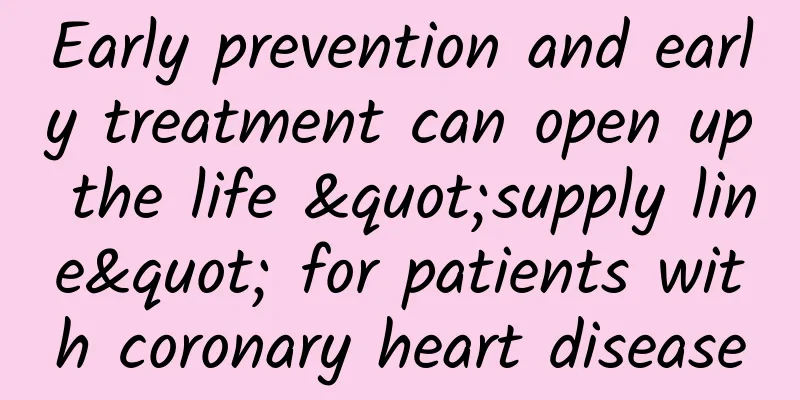Early prevention and early treatment can open up the life "supply line" for patients with coronary heart disease

|
Editor’s Note: As the "three major killers" threatening the health of our country's people, coronary heart disease, stroke and lung cancer have always been the main targets of medical experts. In recent years, more and more new technologies and new concepts have been applied to the diagnosis and treatment of these diseases, helping doctors to extend the life of more patients and improve the quality of life. To this end, People's Daily Online and the Population Culture Development Center of the National Health Commission have launched a series of video reports to introduce disease knowledge and cutting-edge technologies in the medical field, and look forward to future medical trends. Cardiovascular disease has become the number one killer threatening human life and health. As a chronic disease, early detection, early diagnosis, and early treatment are one of the most effective ways to combat coronary heart disease. At present, what new technologies and methods can doctors use to assist in early screening, early diagnosis, and early treatment of cardiovascular disease? In this regard, Chen Yundai, director of the Department of Cardiovascular Medicine of the General Hospital of the People's Liberation Army and chairman of the Cardiovascular Medicine Committee of the PLA, and Xia Yunlong, president of the First Affiliated Hospital of Dalian Medical University, shared with netizens. Coronary heart disease can easily induce sudden cardiac death, which is a great harm to society The heart is one of the most important organs in a living individual. It is like a precisely designed water pump that transports blood to all parts of the body through the contraction and relaxation of myocardial cells. Whether the heart functions normally is the basic premise for the existence of human life. Data released by the World Health Organization in December 2020 showed that the number of deaths from ischemic heart disease each year increased from 7 million in 2000 to 9 million in 2019, accounting for 16% of the total global deaths. Coronary heart disease can easily induce sudden cardiac death, which is very harmful Coronary heart disease generally refers to coronary atherosclerotic heart disease, which is one of the most common cardiovascular diseases. Chen Yundai, director of the Department of Cardiovascular Medicine of the PLA General Hospital and chairman of the PLA Cardiovascular Medicine Committee, said that if the heart is compared to a pump in the human body, the coronary artery is equivalent to its pipeline. Once the pipeline is blocked and the oil line is blocked, the engine pump will stop. Once the coronary artery is not supplied with enough blood and oxygen, angina pectoris will occur, which is coronary atherosclerotic heart disease. "In my country, there are at least 550,000 cases of sudden cardiac death every year. This type of sudden death occurs suddenly, has very poor prognosis, and is very harmful to society," said Xia Yunlong, director of the First Affiliated Hospital of Dalian Medical University. The success rate of stent surgery has increased, but the drawbacks still exist Currently, the treatments for coronary heart disease include two categories: medication and surgery. Drug treatment is a long-term process and is very important for improving the intravascular environment. However, if you are facing a patient with an acute onset and the risk of sudden death at any time, surgery is the best option. Heart stenting is the most common surgery for coronary heart disease At present, heart stents are the most common coronary heart disease surgery. With a clearer surgical field of view, the popularity and success rate of stent implantation are constantly improving, but there are still fatal drawbacks such as antigen-antibody reaction, inflammatory reaction, embolism, and abnormal coagulation. In the future, will it be possible to receive early warnings from the heart and curb coronary heart disease in its infancy at a lower cost? Experts believe that early diagnosis and screening are key factors. In the future, using big data, it is possible to receive early warnings from the heart and curb coronary heart disease in its infancy at a lower cost. Early diagnosis and screening technology continues to improve and become more accurate and efficient As a chronic disease, early detection and early treatment are one of the most effective ways to fight against coronary heart disease. There are many commonly used methods for diagnosing coronary heart disease in clinical practice, including blood tests, electrocardiograms, echocardiograms, coronary CT, etc. Xia Yunlong introduced that among the many screening methods, the most economical, convenient and efficient predictor of sudden cardiac death is the electrocardiogram. In recent years, with the continuous upgrading of medical imaging equipment, intravascular ultrasound (IVUS) and optical coherence tomography (OCT) have gradually been used in clinical practice. Clinicians can now obtain three-dimensional images of human blood vessels through minimally invasive intervention, making diagnosis more accurate. Doctors use intravascular ultrasound and optical interferometry tomography to obtain three-dimensional images of the blood vessels. At the same time, doctors also use blood flow reserve fraction measurement technology to evaluate vascular function. "The essence of improving blood vessels is whether the blood flow in the blood vessels and the area to be supplied are balanced. After functional evaluation, if the blood flow function is sufficient, there is no need to move the blood vessels even if they are 75% or even 80% narrowed," Chen Yundai explained. Doctors remotely diagnose via cloud ECG network In order to increase the efficiency and coverage of coronary heart disease screening, in recent years, related remote diagnosis technologies have also been applied to major domestic hospitals and grassroots community health service institutions. Xia Yunlong said that if primary medical institutions are unable to make a diagnosis and judgment, doctors in large hospitals can make a remote diagnosis online by simply uploading the patient's electrocardiogram to the associated equipment with one click. In the future, if a cloud platform is established and the auxiliary functions of artificial intelligence technology are applied, it can play a greater role. |
<<: Where is Huaguo Mountain? What is there to do in Huaguo Mountain?
>>: Why are frozen pears black? (The pear's tissue is damaged but not spoiled)
Recommend
Can I drink alcohol after an abortion?
No matter what type of abortion, it will cause ce...
How to repel mosquitoes during pregnancy
We all know that women’s immunity will be particu...
How much do you know about food safety? It is essential for a healthy life
"Students, what are your favorite snacks?&qu...
What is beef brisket? How to cook it deliciously
Beef brisket can be used as a raw material to mak...
What is the effect of frequently increasing the speed on the engine? How to reduce the speed of the car at high speed?
In addition to the speed, the car's dashboard...
How long should I eat ginger after caesarean section to avoid scars?
Caesarean section is a method of delivery that ma...
#千万IP创科学普# To prevent lumbar disc herniation, remember six key points!
Editor's Note Since 2023, the Quanzhou Scienc...
Eight months of pregnancy, fetal movement decreases and becomes weaker
The eighth month of pregnancy is a mid-to-late st...
How to treat left lower abdominal pain after childbirth
The body of a postpartum woman is still in a reco...
Acne on face before menstruation
In daily life, every woman's daily life is di...
Uterine fibroids treatment
If uterine fibroids do not have any particularly ...
What's wrong with my period not coming?
In recent years, more and more women have experie...
I need to take medicine during breastfeeding. Which one is safer? Can I still breastfeed?
Author: Zhang Lan, Chief Pharmacist, Shanghai Mat...
What to do if you have tinnitus during menstruation
Tinnitus during menstruation is a condition that ...









